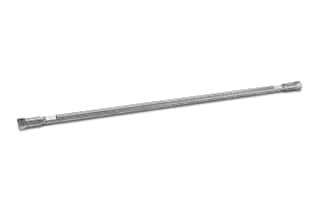
Primarily supports legacy methods. BioSuite SEC Columns are available in 4.6 mm, 7.5 mm, and 7.8 mm i.d. analytical and 21.5 mm i.d. preparative and guard columns.
|
Chemistry |
Diol (OH) |
|
Separation Mode |
SEC |
|
Particle Substrate |
Silica |
|
pH Range Min |
2.5 pH |
|
pH Range Max |
7.5 pH |
|
Maximum Pressure |
1800 psi (124 bar) |
|
Endcapped |
Yes |
|
Molecular Weight Range Min |
5000 |
|
Molecular Weight Range Max |
150000 |
|
Particle Shape |
Spherical |
|
Particle Size |
4 µm |
|
Endfitting Type |
Parker-style |
|
Pore Size |
125 Å |
|
Format |
Column |
|
System |
HPLC |
|
USP Classification |
L59 |
|
Inner Diameter |
4.6 mm |
|
Length |
300 mm |
|
UNSPSC |
41115709 |
|
Application |
Protein |
|
Brand |
BioSuite |
|
Product Type |
Columns |
|
Units per Package |
1 pk |

BioSuite Diol (OH) Column, 125Å, 4 µm, 4.6 mm X 300 mm, 5K - 150K, 1/pk
BioSuite SEC Columns are offered in analytical sizes of 4.6 mm, 7.5 mm, and 7.8 mm i.d., as well as preparative and guard columns of 21.5 mm i.d. The BioSuite Diol (OH) Column is built with High Resolution (HR) packing, which is made of wettable silica-based material and gives the column rigidity and chemical stability throughout a pH range of 2.5 to 7.5. The BioSuite Diol (OH) Column's length and particle size have boosted separation efficiency.
The BioSuite Diol (OH) Column is designed to tackle the demands of protein and peptide analysis. The chemistry of the BioSuite Diol (OH) Column makes it perfect for protein and peptide isolation, analysis, and characterization. Given the demanding nature and requirements of chromatographic analysis, each BioSuite Diol (OH) Column undergoes extensive testing to ensure product quality and batch-to-batch and column-to-column repeatability. This BioSuite Diol (OH) Column is ideal for the How Do You Calculate Protein Mass?
According to conventional calculations, the molecular weights of the amino acids are added to determine the molecular weight of a protein examination of spherical 13 m particles with molecular weights ranging from 5,000 to 150,000 Daltons.
The BioSuite Diol (OH) Column will provide you with exceptional resolution and recovery of proteins and peptides, as well as good results. By adequately characterizing complicated biomolecules, you can rely on the BioSuite Diol (OH) Column to address your protein separation and characterization challenges and generate successful protein-based biopharmaceuticals and diagnostic reagents. This makes the BioSuite Diol (OH) Column an essential piece of lab equipment since it allows you to apply orthogonal separation techniques to create the next generation medicine by displaying important characterization data and isolated components.
Browse our website and refer to our catalog to learn more about the variations of the same product, such as the BioSuite Diol (OH) Column featured here, or to locate different goods that work with it, or even to shop for lab equipment so you may replace your stock and add to your existing equipment portfolio.
You might also be interested in the BioSuite Diol (OH) Guard Column, 5 µm, 6 mm X 40 mm, 1/pk, which was constructed with the same packing material as the analytical column and is therefore appropriate for use with it. The Guard Column removes any dangerous chemical or particle pollutants from the mobile phase, thereby protecting your analytical column and enhancing its lifetime and efficiency.
How Is Protein Mass Calculated?
The molecular weight of a protein is calculated by adding up the molecular weights of the amino acids, per standard calculations.